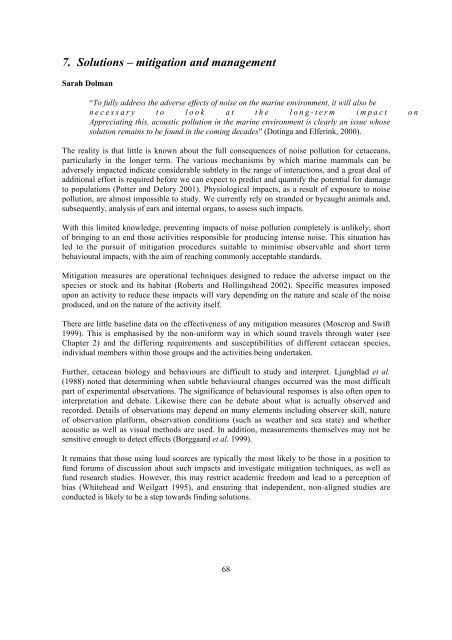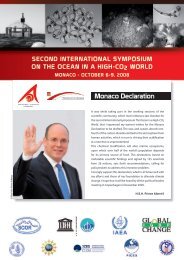Oceans of noise - Whale and Dolphin Conservation Society
Oceans of noise - Whale and Dolphin Conservation Society
Oceans of noise - Whale and Dolphin Conservation Society
- No tags were found...
You also want an ePaper? Increase the reach of your titles
YUMPU automatically turns print PDFs into web optimized ePapers that Google loves.
7. Solutions – mitigation <strong>and</strong> managementSarah Dolman“To fully address the adverse effects <strong>of</strong> <strong>noise</strong> on the marine environment, it will also benecessary to look at the long-term impact onAppreciating this, acoustic pollution in the marine environment is clearly an issue whosesolution remains to be found in the coming decades” (Dotinga <strong>and</strong> Elferink, 2000).The reality is that little is known about the full consequences <strong>of</strong> <strong>noise</strong> pollution for cetaceans,particularly in the longer term. The various mechanisms by which marine mammals can beadversely impacted indicate considerable subtlety in the range <strong>of</strong> interactions, <strong>and</strong> a great deal <strong>of</strong>additional effort is required before we can expect to predict <strong>and</strong> quantify the potential for damageto populations (Potter <strong>and</strong> Delory 2001). Physiological impacts, as a result <strong>of</strong> exposure to <strong>noise</strong>pollution, are almost impossible to study. We currently rely on str<strong>and</strong>ed or bycaught animals <strong>and</strong>,subsequently, analysis <strong>of</strong> ears <strong>and</strong> internal organs, to assess such impacts.With this limited knowledge, preventing impacts <strong>of</strong> <strong>noise</strong> pollution completely is unlikely, short<strong>of</strong> bringing to an end those activities responsible for producing intense <strong>noise</strong>. This situation hasled to the pursuit <strong>of</strong> mitigation procedures suitable to minimise observable <strong>and</strong> short termbehavioural impacts, with the aim <strong>of</strong> reaching commonly acceptable st<strong>and</strong>ards.Mitigation measures are operational techniques designed to reduce the adverse impact on thespecies or stock <strong>and</strong> its habitat (Roberts <strong>and</strong> Hollingshead 2002). Specific measures imposedupon an activity to reduce these impacts will vary depending on the nature <strong>and</strong> scale <strong>of</strong> the <strong>noise</strong>produced, <strong>and</strong> on the nature <strong>of</strong> the activity itself.There are little baseline data on the effectiveness <strong>of</strong> any mitigation measures (Moscrop <strong>and</strong> Swift1999). This is emphasised by the non-uniform way in which sound travels through water (seeChapter 2) <strong>and</strong> the differing requirements <strong>and</strong> susceptibilities <strong>of</strong> different cetacean species,individual members within those groups <strong>and</strong> the activities being undertaken.Further, cetacean biology <strong>and</strong> behaviours are difficult to study <strong>and</strong> interpret. Ljungblad et al.(1988) noted that determining when subtle behavioural changes occurred was the most difficultpart <strong>of</strong> experimental observations. The significance <strong>of</strong> behavioural responses is also <strong>of</strong>ten open tointerpretation <strong>and</strong> debate. Likewise there can be debate about what is actually observed <strong>and</strong>recorded. Details <strong>of</strong> observations may depend on many elements including observer skill, nature<strong>of</strong> observation platform, observation conditions (such as weather <strong>and</strong> sea state) <strong>and</strong> whetheracoustic as well as visual methods are used. In addition, measurements themselves may not besensitive enough to detect effects (Borggaard et al. 1999).It remains that those using loud sources are typically the most likely to be those in a position t<strong>of</strong>und forums <strong>of</strong> discussion about such impacts <strong>and</strong> investigate mitigation techniques, as well asfund research studies. However, this may restrict academic freedom <strong>and</strong> lead to a perception <strong>of</strong>bias (Whitehead <strong>and</strong> Weilgart 1995), <strong>and</strong> ensuring that independent, non-aligned studies areconducted is likely to be a step towards finding solutions.68




